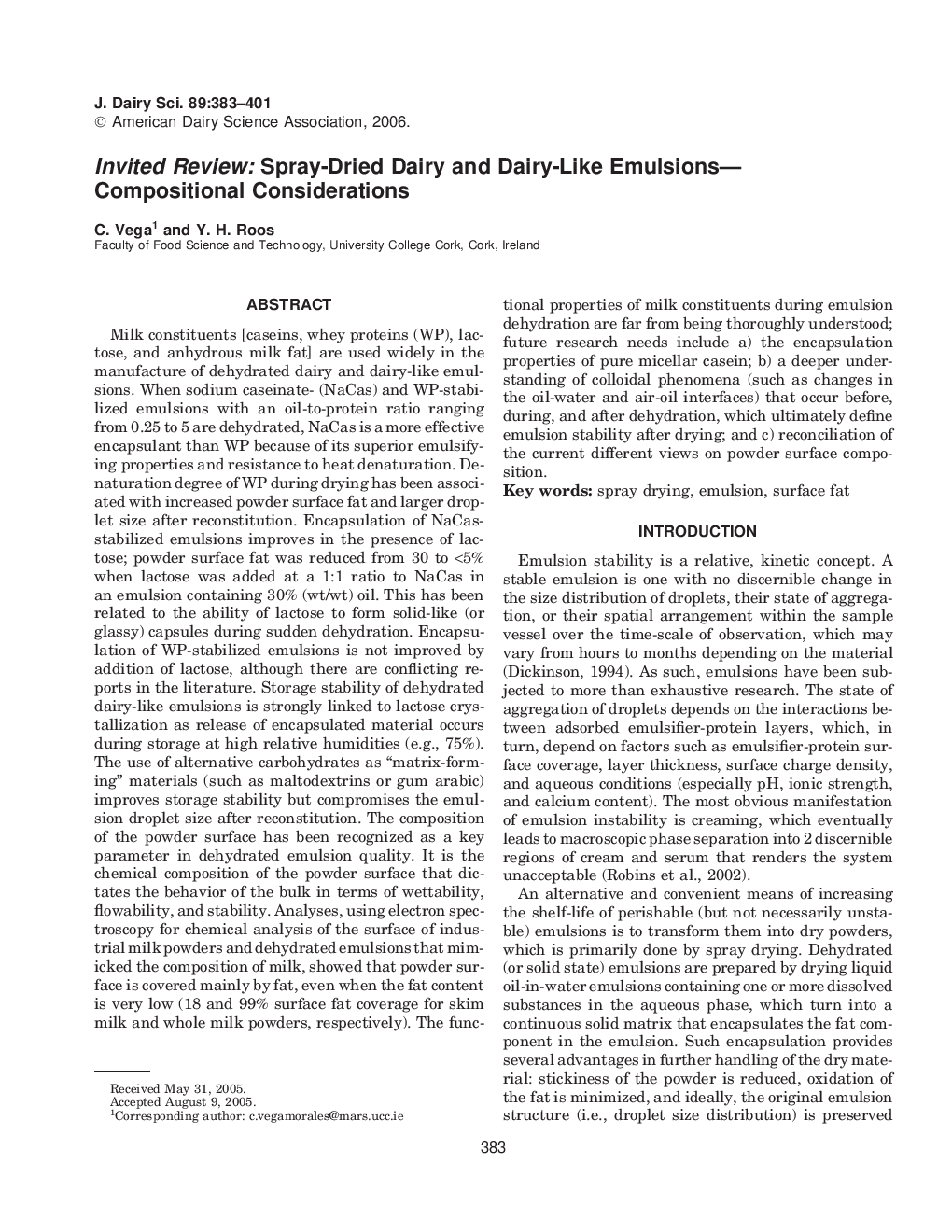| کد مقاله | کد نشریه | سال انتشار | مقاله انگلیسی | نسخه تمام متن |
|---|---|---|---|---|
| 2441194 | 1108134 | 2006 | 19 صفحه PDF | دانلود رایگان |
عنوان انگلیسی مقاله ISI
Invited Review: Spray-Dried Dairy and Dairy-Like Emulsions-Compositional Considerations
دانلود مقاله + سفارش ترجمه
دانلود مقاله ISI انگلیسی
رایگان برای ایرانیان
موضوعات مرتبط
علوم زیستی و بیوفناوری
علوم کشاورزی و بیولوژیک
علوم دامی و جانورشناسی
پیش نمایش صفحه اول مقاله

چکیده انگلیسی
Milk constituents [caseins, whey proteins (WP), lactose, and anhydrous milk fat] are used widely in the manufacture of dehydrated dairy and dairy-like emulsions. When sodium caseinate- (NaCas) and WP-stabilized emulsions with an oil-to-protein ratio ranging from 0.25 to 5 are dehydrated, NaCas is a more effective encapsulant than WP because of its superior emulsifying properties and resistance to heat denaturation. Denaturation degree of WP during drying has been associated with increased powder surface fat and larger droplet size after reconstitution. Encapsulation of NaCas-stabilized emulsions improves in the presence of lactose; powder surface fat was reduced from 30 to <5% when lactose was added at a 1:1 ratio to NaCas in an emulsion containing 30% (wt/wt) oil. This has been related to the ability of lactose to form solid-like (or glassy) capsules during sudden dehydration. Encapsulation of WP-stabilized emulsions is not improved by addition of lactose, although there are conflicting reports in the literature. Storage stability of dehydrated dairy-like emulsions is strongly linked to lactose crystallization as release of encapsulated material occurs during storage at high relative humidities (e.g., 75%). The use of alternative carbohydrates as “matrix-forming” materials (such as maltodextrins or gum arabic) improves storage stability but compromises the emulsion droplet size after reconstitution. The composition of the powder surface has been recognized as a key parameter in dehydrated emulsion quality. It is the chemical composition of the powder surface that dictates the behavior of the bulk in terms of wettability, flowability, and stability. Analyses, using electron spectroscopy for chemical analysis of the surface of industrial milk powders and dehydrated emulsions that mimicked the composition of milk, showed that powder surface is covered mainly by fat, even when the fat content is very low (18 and 99% surface fat coverage for skim milk and whole milk powders, respectively). The functional properties of milk constituents during emulsion dehydration are far from being thoroughly understood; future research needs include a) the encapsulation properties of pure micellar casein; b) a deeper understanding of colloidal phenomena (such as changes in the oil-water and air-oil interfaces) that occur before, during, and after dehydration, which ultimately define emulsion stability after drying; and c) reconciliation of the current different views on powder surface composition.
ناشر
Database: Elsevier - ScienceDirect (ساینس دایرکت)
Journal: Journal of Dairy Science - Volume 89, Issue 2, February 2006, Pages 383-401
Journal: Journal of Dairy Science - Volume 89, Issue 2, February 2006, Pages 383-401
نویسندگان
C. Vega, Y.H. Roos,